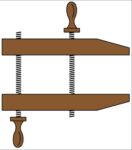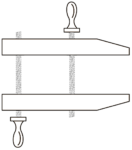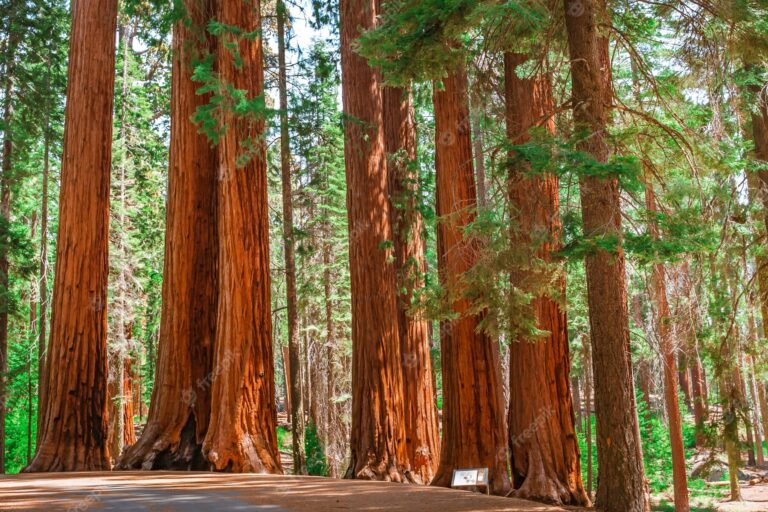A 2013 SDFWA newsletter article about the bristlecone pine described the longest living tree. This article is about the biggest and tallest trees, the redwoods. They comprise the genus Sequoia which includes three species. Nomenclature can be confusing. Two of the three species grow naturally only in California and are often lumped together as “California redwoods”.
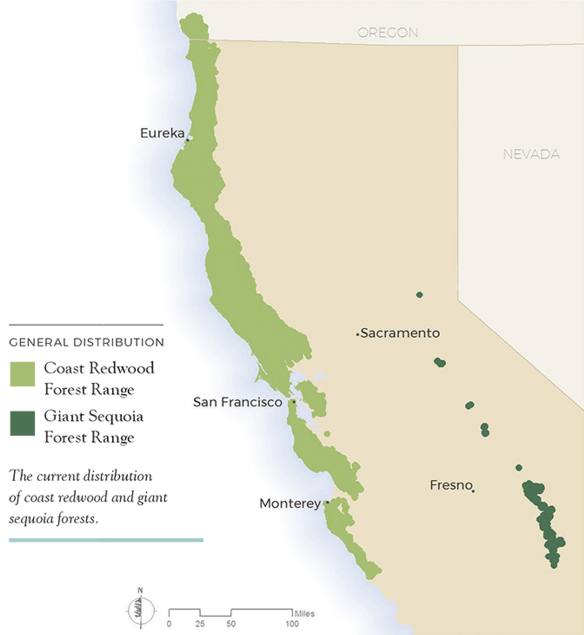
Coast redwoods (Sequoia sempervirens), once covered two million acres before 1850 in a one-thirty mile wide corridor from Big Sur to southern Oregon along the Pacific coast. “Hyperion”, a Coast redwood and the world's tallest living tree, was discovered in 2006, height 380 feet. Its location has been kept secret. The maximum age for Coast redwoods is 2,000 years though few trees survive that long. They grow best in a maritime environment, especially the coastal summer fog belt. Today, protected old growth Coast redwood forests cover 382,000 acres; only 5% of the original old growth forest. Logging companies now own about 1.2 million acres. Millions of years ago many extinct redwood species, today known only as fossils, grew world wide from North America to the coastal areas of Europe and Asia.
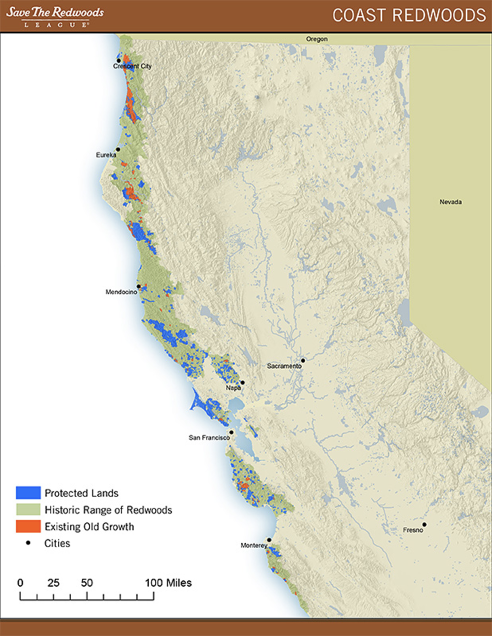
The Giant sequoia, (Sequoiadendron giganteum); also “Sierra redwood”, “Big Tree” or simply “Sequoia” is very habitat specific. It grows best at elevations from 5,000 to 7,000 feet in the western foothills of the Sierra Nevada; limited to about 70 groves mixed with white fir and sugar pine. The first non-native to see a Giant sequoia, a game hunter named Dowd, walked into a grove in Calaveras County in 1852. As soon as the existence of these giants became known, two huge trees were felled and cut into pieces in order to be sent to New York and Paris for public display. The Calaveras grove was privately acquired and extensively logged. The Mariposa grove was protected by Congress in 1864
The oldest living Giant sequoia, “President”, is 3,240 years old. Sequoia, seldom over 200 feet tall, do not reach the height of Coast redwoods, but they can be much greater in volume. “General Sherman”, the largest living tree, weighs an estimated 2.7 million pounds (52,508 cubic feet in volume) with a circumference of 102 feet at ground level. The remaining Giant sequoias cover 48,000 acres and are now nearly all protected.
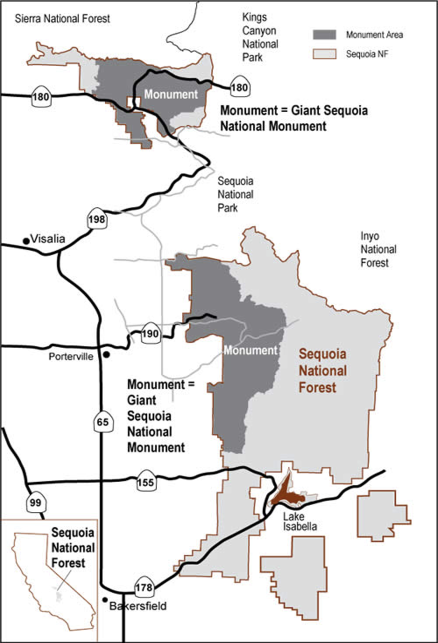
The third surviving species, “Dawn Redwood” (Metasequoia glyptostroboides), a living fossil, was thought to be extinct until a small grove was found growing naturally in a valley in S. Central China. It has been exported as an ornamental curiosity all over the world.
Redwood roots extend below ground only six to twelve feet but spread up to 100 feet from the base, intertwining with the roots of near by trees, greatly increasing their stability, but rendering redwoods vulnerable to damage when foot traffic compacts soil around the base of the tree. In the temperate areas where Coast redwoods live, rain provides water in winter. In summer they depend on fog which condenses on needles, forming droplets that are absorbed or fall to the ground, watering both trees and the forest undergrowth. Fog accounts for 40% of the redwoods' moisture intake; the same process that supports our local Torrey Pines. Giant sequoias require a lot of water and are being adversely affected by the current drought.
Scattered among the coast redwood forests are approximately 400 small redwood trees, stripped of color and completely lacking in chlorophyll.
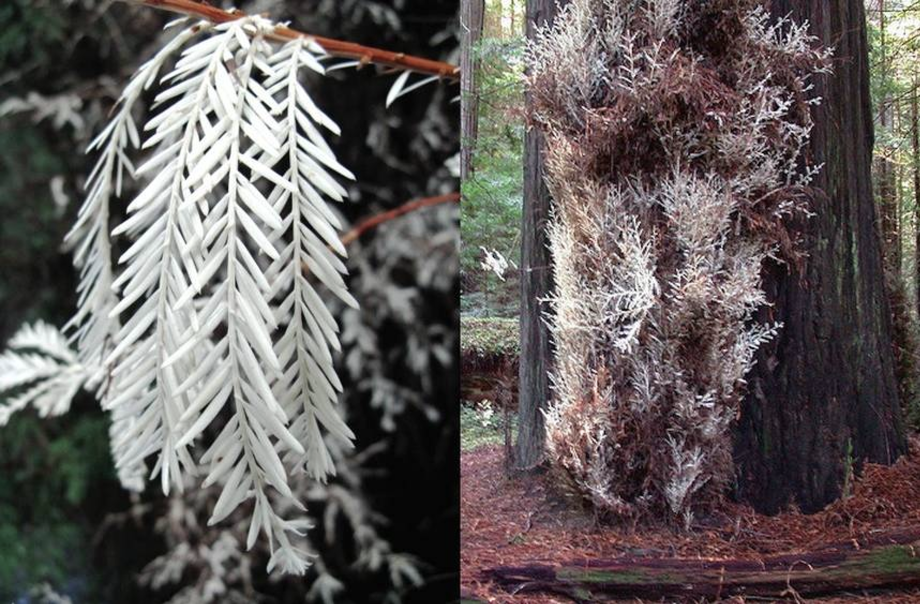
Zane Moore at U. C. Davis found that these white, so-called “ghost redwoods” are full of cadmium, copper, nickel and other noxious metals; on average twice as much heavy metal as their green relatives. These albino trees pull heavy metals out of the soil. In symbiosis with healthy trees, they act as a reservoir for poison in exchange for sugars they need to survive.
Redwood pinecones are only an inch in length, each bears up to a few dozen seeds. The heartwood is rich in tannin, giving protection from insects and decay. Redwood bark is up to 12 inches thick which enables the trees to survive most forest fires. Natural fires create room for seedlings to grow and help redwood cones to open. Suppression of these low intensity fires fosters growth of dense undergrowth. Competition with seedlings for nutrients leads to extreme fires which can kill mature redwoods.
Recent research shows that mature Coast redwood forests can store huge amounts of CO2, as much as 2,600 metric tons of carbon per hectare (2.4 acres); more than any other forest in the world, making them an important ally in fighting climate change. Redwoods are the fastest growing tree and have more than double the carbon absorption rate of Pacific Northwest conifers or Australia’s eucalyptus forests.
Redwood trees are able to clone themselves, resulting in a complex network of roots with which trees communicate. In adverse conditions the trees use this network to share nutrients. The process has been demonstrated by injecting dye into trees at one side of a grove and tracing it to trees at the opposite side.
Intensive logging of redwoods began after the gold rush in 1850. Because coast redwood has exceptional properties of durability, stability and workability it quickly became prized for building. Mature trees produce lumber which is 60% vertical grain, knot free heartwood. In 1853 nine sawmills were operating in Eureka. By 1900 timber companies had acquired 100% of the coast redwood habitat; much of it through fraudulent land swaps from the public domain and the practice of making a purchase with a down payment, clear cutting trees and then defaulting on the balance of the debt.
Mechanization also led to an increase in the rate of harvesting. Coast redwoods were logged first because access to them was easier plus the fact that the lumber was superior to that from older Giant sequoias, which is relatively brittle. Giant sequoia were also extensively logged in the late 1800s and early 1900s; but not very profitably because trees often shattered when felled due to their brittleness and great weight. The usable wood mainly went for shingles, fence posts and even matchsticks and had less monetary value than Coast redwoods.
In 1889 Kings River Lumber Co. owned 30,000 acres near Sequoia National Park. They used redwood to build two sawmills near Millwood plus a 54 mile long lumber flume to Sanger. Two years later they built a 3-foot gauge railroad using two 2-truck shays to haul nearby logs to the mills. The company lost money in spite of all this. Creditors reorganized the operation as the Sanger Lumber Company in 1895, moved it five miles east to Converse Basin, built a new mill, managed to loose money each of the next 10 years and gained a reputation as the most destructive logging operation ever. They felled over 8,000 Giant Sequoias without earning a profit.
The existence of all remaining stands of redwood trees today is due to the efforts of conservation organizations such as the Sierra Club and Save the Redwoods League in addition to a growing public appreciation of their unique value. The decades long fight to protect redwood forests is detailed in an excellent book; Trees in Paradise by Jared Farmer.
What about using redwood for fine woodworking? First of all it is soft; except for balsa, the softest of all the 70+ species listed on the Janka Hardness Scale. Second growth redwood is also subject to splitting and tear out. The closer to flatsawn a plank is, the more likely a raised surface will show after finishing where the edge of a growth ring is exposed. Redwood burl is a special case. It can produce exceptional pieces in the right hands. Second and later growth redwood is readily available but is no comparison to lumber from old growth trees which is outstanding in strength, color, stability and taking a finish. If you visit the Marston House in Balboa Park you can see old growth redwood used as interior architecture.
Old growth redwood can be recognized by examining growth ring spacing in a cross cut surface; the narrower the ring spacing, the older the tree. Unfortunately, genuine old growth redwood is scarce, and expensive: basically only available in the form of reclaimed lumber from sources such as dams, barns, water or wine barrels. Salvaged redwood will be weathered to a silvery gray color unless it comes from interior architectural sources where natural color and surface is preserved. Typical websites for these sources are http://www.rhinewood.com/ https://vintagetimber.com/.
Want to plant your own redwood forest? Although they are not likely to thrive in San Diego, seedlings for both Coast and Giant redwood are inexpensive and readily available on eBay.
Here are some links for more information
https://www.treehugger.com/natural-sciences/10-tallest-trees-world.html
http://www.sangerdepotmuseum.com/history-of-the-flume
https://en.wikipedia.org/wiki/Hume-Bennett_Lumber_Company
https://www.savetheredwoods.org/redwoods/interactive-redwood-forest-facts/
By Dick Ugoretz (originally published on July 2017)
Editor's Note: Light edits have been made to remove broken web links.
